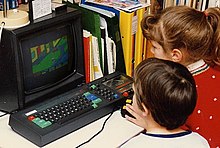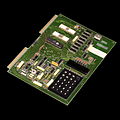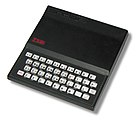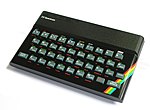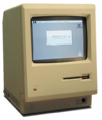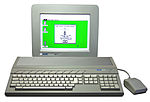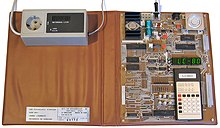Home computers
Home computer (from the English home computer ) was a common name in the 1980s for a class of microcomputers that were mainly used in private households . By definition, these devices are personal computers in the narrower sense , with the home computer including the part of such devices that are found in the lower price segment and were intended more for entertainment purposes and for programming by the user. Due to the rapidly growing spread of home computers in the private sector, broader strata of the population came into contact for the first time with computers that only a few years earlier had only been accessible to specialist staff in companies.
One of the common features of almost all early home computers of the 1980s was that they had a keyboard integrated into the housing, with which they were operated via command line commands , that they were designed for connection to a television set and that the operating system , which was permanently installed on a ROM memory chip, was also included had an interpreter for the easy-to-learn BASIC programming language . The most widespread microprocessors were those of the 6502 family and the Zilog Z80 , which were usually clocked at around 1 MHz to 4 MHz and initially used 1 to 16, later up to 64 kB of RAM .
From around the end of the 1980s, models with the Motorola 68000 processor , which already had graphic user interfaces with mouse operation and were equipped with memory in the megabyte range, enjoyed great success . In the mid-1990s, however, most of these incompatible systems disappeared from the market, and PCs with the Windows operating system and x86 processors established themselves as the standard in the private sector.
The development of home computers went hand in hand with the development of game consoles and computer games . For some home computer models, there were technically almost identical devices as game consoles, which only lacked the keyboard .
precursor
The first digital, programmable computer for home use was the Simon relay calculator , introduced in 1949 by Edmund Berkeley , the founder of ACM . Simon consisted of only 50 relays and had no microprocessor . Only a construction plan for Simon was commercially available , of which over 400 copies were sold in the first ten years of its availability.
The Micral N was another forerunner on the way to the home computer; the first of its kind with a microprocessor , in this case an Intel 8008 . Production began in the spring of 1973. With the Altair 8800 from MITS , a series-produced device came onto the market in 1975, which was available as a kit for 397 US dollars and as a complete unit for 695 US dollars . The equipment with a bus plug-in system for expansion cards based on the S-100 bus standard was pioneering. With its toggle switches as input unit and light-emitting diodes as output unit, however, this device also does not technically correspond to what is understood today as a home computer. It was similar with the KIM-1 from MOS Technology , released in the same year, which already had a 24-key input unit in pocket calculator format for direct input of HEX codes and a 6-digit 7-segment LED display as output unit . As a result, these devices were largely unsuitable and hardly attractive for average private users; they were mainly bought by the electronics hobbyist and the few early computer enthusiasts. The number of items sold was therefore low.
The MITS Altair 8800 enjoyed great popularity within the early hacker scene surrounding the Homebrew Computer Club , which was a decisive factor in the development of the home computer, and served the club members as a centerpiece for their own expansions.
Micral N
(1973)Altair 8800
(1975)KIM-1
(1976)
1970s
The beginnings of the home computer in the modern sense, with typewriter-like keyboard as an input unit and a screen (initially in the form of a repurposed television) as an output unit, started in 1976 with the Apple I . It was designed as a single-board computer , whereby the user himself had to procure parts such as power supply unit , housing, screen and keyboard and configure them at great expense. As the first device in the world, it was affordable for private households at 666 US dollars and at the same time corresponded to the modern operating concept of a home computer.
At the Consumer Electronics Show , which took place in Las Vegas ( Nevada ) in April 1977, three models were presented to the interested public for the first time in 1977, which were immediately ready for domestic or operational use, not as a kit, but as fully assembled devices. These include the inexpensive TRS-80 (US $ 599) from the large electronics chain RadioShack , the open architecture but expensive Apple II (US $ 1298) and the all-in-one model Commodore PET 2001 (US $ 795) -Dollar).
In 1979, the Atari 400 was the first home computer on the market that contained custom chips and was therefore technologically ahead of the competition. In the same year, Texas Instruments installed a 16-bit processor in the TI-99/4 for the first time , although the computer did not succeed. In 1980 came in the UK the ZX80 by Sinclair in the trade, on the main processor Z80 of Zilog based and the first time a home computer industry outside North America helped to establish.
Between 1977 and 1980 Tandy dominated the US microcomputer market with the TRS-80; The competitors had no equivalent sales network to oppose the RadioShack stores, which were ubiquitous at the time. Outside the USA, the market for microcomputers was still very small at that time, which was also due to the much higher prices for such devices there. In Germany, Commodore was the market leader, followed by Atari and Sinclair .
Apple I
(1976)Apple II
(1977)Tandy TRS-80
(1977)Commodore PET 2001
(1977)
Atari 400
(1979)Atari 800
(1979)TI-99/4
(1979)Sinclair ZX80
(1980)
1980s
IBM was one of the leading producers of mainframes ; For a long time, corporate management had considered the new market for personal computers to be unprofitable and neglected it. In 1981 this changed with the release of the IBM PC . After an agreement with Digital Research failed, then the leading provider of microcomputer operating systems , has been on an offer from Microsoft resorted to the IBM now on PC DOS called MS-DOS . The market position of IBM ensured that the IBM PC quickly established itself in the office sector - many companies wanted to obtain their workstation computers from a single source. The IBM PC with its 3,005 US dollars (in the basic configuration) was too expensive for home use. However, the IBM company disclosed the basic design of its PC and created an informal industry standard; it thus defined the device class of " IBM PC-compatible computers " that is still current today . Numerous inexpensive replicas and continuations of the IBM PCs by other companies made the platform very successful in the workplace as well as in the home; Today's commercially available computers with Windows operating systems and x86 processors are based on the continuous development of the IBM design at the time.
At the end of 1982 Commodore launched the C64 as the successor to the VC20 . Due to its considerably lower price compared to the “professional” computers such as the Apple II and the IBM PC, the so-called “bread box” quickly became the best-selling home computer of all time. At around the same time, Sinclair Research also marketed its two popular models, the Sinclair ZX81 and its successor, the ZX Spectrum, with great success . In contrast to these two, Sinclair's last technically advanced computer, the Sinclair QL ("Quantum Leap") , which has been available since 1984, only led a pure niche existence in the computer market due to production delays, quality deficiencies and errors in marketing .
In 1982 Atari brought out an internally only slightly changed version of the 400/800 series due to the growing competitive pressure with the XL series. These computers were cheaper than their predecessors and largely software compatible . Their sales figures in Germany were in second place behind Commodore.
In 1984 and 1985, the CPC series licensed by Amstrad was brought onto the market by the Schneider Computer Division (a division of Schneider Werke ) in Germany. The computers of this series were very successful in Germany, in the country of origin Great Britain and especially in France and Spain. The two models CPC464 and CPC 6128 were named Computer of the Year in Germany in 1985 and 1986.
Commodore VC 20
(1981)TI-99 / 4A
(1981)BBC Micro
(1981)Sinclair ZX81
(1981)Commodore 64
(1982)
ZX Spectrum
(1982)Apple IIe
(1983)Atari 800XL
(1983)Amstrad CPC464
(1984)Commodore Plus / 4
(1984)
After a few failures with new models such as the Apple III, Apple has now concentrated on the avant-garde , extremely user-friendly and expensive personal computer Apple Macintosh . With this it achieved a leading position in the high-end area, especially in the promising desktop publishing and computer-aided graphic design.
In 1985, however, a new generation of home computers came onto the market with the Commodore Amiga and the Atari ST , which were among the top technological leagues of the time. Both used the Motorola 68000 processor, which was also used in the Macintosh, and offered previously unknown graphic possibilities in the home . Processor and memory equipment could easily keep up with the top model of the IBM PC series, the IBM AT . The graphical user interface was also new . With the Atari ST, the “ look and feel ” was based heavily on the Apple Macintosh, the Amiga showed more independence here. Windows, on the other hand, was still in its infancy at the time; no PC user could do without knowledge of DOS, which was operated by entering text on a command line.
Due to these advantages and in connection with the low price, the Atari ST quickly achieved high sales figures in Europe in the first two years of sales and, thanks to its high-resolution black / white monitor, was also used in the professional sector ( desktop publishing , accounting, secretariat, cash register computer ) . Thanks to the built-in MIDI interfaces, however, it primarily took a leading position in music production .
From 1987, after the appearance of the inexpensive Amiga 500, the market share of the Amiga exceeded the sales figures of the Atari ST by far. The significantly improved graphics and sound output of the Amiga (compared to the C64) made the computer an inexpensive computer, especially for gamers, as did the fact that Commodore mainly offered color monitors for the Amiga. While Atari stopped producing computers in 1994, Amigas continued to be produced until 1996.
Around the same time also the first appeared Archimedes Computers of the British manufacturer Acorn , who on 32-bit - RISC based processors and technology was ahead of its time. However, it never achieved sufficient market penetration, the software offering remained small. However, Acorn kept development until 1998 before production ceased. The very advanced processor technology developed by Acorn at that time is being further developed as ARM architecture by the Acorn successor company ARM Limited and licensed to processor manufacturers such as Samsung . Almost all of today's smartphones and tablet computers , such as the Apple iPhone and the Samsung Galaxy series , are based on a processor with ARM technology.
Apple IIc
(1984)Apple Macintosh
(1984)Sinclair QL
(1984)Commodore 128
(1985)Schneider CPC6128
(1985)Amiga 1000
(1985)Atari 1040STf
(1986)Apple IIgs
(1986)Amiga 500
(1987)Acorn Archimedes A3000
(1989)
The technology of the first years
Commercially available compact cassettes (audio cassettes) were mainly used as mass storage devices outside the USA , sometimes with special simple cassette recorders, in the case of the C64 called Datasette , and sometimes with conventional music cassette recorders. Floppy disk drives , usually in the 5¼ inch format, were mostly available as accessories, and these often reached or exceeded the price of the basic device. In the USA, however, they were more common than the slow, error-prone, and impractical cassettes. The television was usually used as the screen instead of a special computer monitor, which is why there were slightly different PAL and NTSC models of most home computer models, depending on the television standard in the country of sale. The home computers were usually equipped with a graphics chip and a sound chip and were therefore able to display simple graphics and generate sounds. The first home computers used 8-bit processors , the vast majority of which were either the Z80 or 6502 derivatives; towards the mid to late 1980s, these were replaced by 16/32-bit types such as the Motorola 68000 . The graphics and sound capabilities became more complex and hard drives and other PC peripherals could be connected.
The operating system and BASIC as the programming language were often stored in ROM and formed a unit, so they did not have to be loaded when starting, which is why most home computers are ready for use within a few seconds after being switched on. With MSX , Microsoft and Sony attempted to standardize the operating system and BASIC and to enable programs to be exchanged between computers from different manufacturers. The MSX standard was successful in South America and Japan, among others, but could not establish itself in Germany.
Consolidation of the market
The home computer market was split up into many incompatible systems in the late 1980s . From the beginning to the mid-1990s was followed by a consolidation phase, after which no home computer in the strict sense were more available - it won the under Microsoft Windows - operating systems running, the IBM-PC compatible personal computers and smaller proportions of the Apple Macintosh as well as in Linux computers on an even smaller scale , mostly based on IBM PC-compatible hardware.
The older systems, which were based on an 8-bit architecture and were inferior to the new 16- or 32-bit processors with their larger address space, disappeared from the market as early as the end of the 80s . (The 8-bit systems mostly had a 16-bit address space with a maximum of 64 KiB RAM, the 16- or 32-bit systems mostly had a 20-, 24- or 32-bit address space; 20-bit addresses allow up to 1 megabyte of RAM.)
The Atari and Amiga systems were the clear winners. However, the companies involved made some entrepreneurial mistakes - among other things by neglecting the professional and the US market and unsuccessful concentration on the European market - which ultimately led them into the red and prevented further development of the technology.
In the early 1990s, the IBM PC became increasingly popular in the home user sector. Some of the main reasons for this were:
- The idea of the open system borrowed from the Apple II ; H. Thanks to the available free slots , a PC could be upgraded with expansion cards (e.g. graphics cards , sound cards ). The competing products, on the other hand, mostly rely on complete systems with only a few expansion options.
- The open technical specifications that made it possible for many manufacturers to make a cheap and / or better replica, as was the case with the Apple II before. In contrast to the Apple II, these replicas were also legal, which also encouraged their use in companies.
- The downward compatibility for software and hardware required by Microsoft, i. H. programs or expansion cards that were designed for an older PC system could also be run on newer systems.
- The large market share of IBM in the office application area, which quickly gained a market advantage in the home user area. Many software manufacturers were very interested in offering professional software in addition to games, as this enabled more profitable profit margins to be achieved ( hacker culture ). The wide range of applications for the office and home had already been the basis of the success of the Apple II.
- Bankruptcies / entrepreneurial mistakes by individual companies did not endanger the “PC ecosystem”. Let us remind you of the Atari Falcon 030 , which did not meet the requirements for a successor to the Atari ST when it was launched at the end of 1992 and whose production was soon discontinued.
After Microsoft was not only able to catch up with the Windows user interface compared to the operating systems of its competitors (Apple Macintosh, Apple IIGS, Atari ST and Commodore Amiga families) at the beginning of the 1990s, but at the same time aggressively pushed and developed games for its own operating system Supported hardware manufacturers in the development of graphics and sound enhancements that made the " personal computers " based on the IBM PC into attractive entertainment devices, Windows quickly became the most popular operating system for personal computers, which thus became "home computers in the broader sense" .

This in turn made Microsoft's market power strong enough that attempts by IBM and other hardware manufacturers to become more independent by developing their own operating systems also failed; OS / 2 and other new developments hardly reached the PC market, which in the meantime had become just as important for the further development of the PC sector as its use as an office computer. The exception (especially in the USA) was Apple back then with Mac OS Classic . However, the Linux architecture has also conquered a share that can no longer be neglected; macOS is also based on a Unix-like core.
Effects on everyday culture
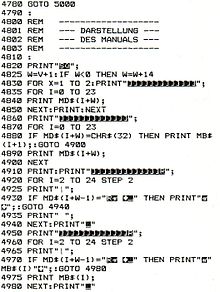
The home computer was the first programmable computer system to become widespread in private households in the early 1980s. Many people were fascinated by the new opportunities and began writing programs themselves as a hobby. At that time, mostly adult men and male adolescents were technology savvy. A phenomenon of this time were the so-called "computer kids", young people between about 12 and 18 years of age who, through intensive work with home computers, developed knowledge and skills that sometimes far exceeded those of their own parents' generation. Partly because of the initially still small supply of finished software, the proportion of self-programmers among the users was much higher and the proportion of only users much lower than today. The computer magazines that were being created at that time also initially addressed programmers to a large extent and often contained page-long program printouts (listings) that often took several hours to type. Many users acquired advanced programming skills in the process. Young computer enthusiasts from this period also formed the first generation of hackers . The American feature film WarGames from 1983 portrayed this connection in a dramaturgical exaggeration.
In many schools, math and physics teachers succeeded in getting their students excited about using computers. Computer science classes as an elective, often held in the afternoon, experienced a strong boom. At the same time, many schools set up their own computer rooms, initially largely on their own and through committed teachers. Contrary to later developments, it was widely assumed at that time that elementary computer skills were synonymous with programming, i.e. writing your own programs, which is why programming languages and learning to program made up the majority of the subject matter. This can also be explained by the fact that - with the exception of the Apple Macintosh , which is far too expensive for average private users - there was practically no computer with a graphical user interface and no widespread standard software such as Microsoft Windows or Office packages whose operation could have been taught .
Home computers in the former Eastern Bloc
In the Eastern bloc , a similar development took place from home computers, as in the West instead. Already coveted before the fall of the Wall , many western home computers found their way to Eastern Europe from 1990 onwards , as they were much cheaper than PCs .
GDR
In the GDR , home computers were renamed small computers when it became clear that domestic production could only meet the demand in schools and companies. The small computers in the GDR were all based on the U880 as a processor , a replica of the Z80 .
The first computers were the Polycomputer 880 and the LC80 (LC for learning computers). These did not have a screen connection and were primarily suitable for learning how a microcomputer works. Segment displays were integrated to display data .
The HC 900 came from the VEB Microelectronics "Wilhelm Pieck" Mühlhausen / Thuringia . It was later sold as the KC 85/2 . Further developments of this series were the KC 85/3 and KC 85/4.
In parallel, in Dresden from Kombinat Robotron developed the Z 9001, later known as KC 85/1 and almost unchanged as KC 87 was sold.
There were also a number of home-made computers, some of whose construction plans were published in magazines.
- Z1013 from Robotron in Riesa , kit where only the keyboard and power supply had to be connected
- AC1 , Ham Radio Computer from Ham Radio Magazine
- Ju-Te-Computer from the magazine Jugend + Technik
In 1989/1990 the KC compact and BIC A 5105 computers , the latter intended as educational computers for schools and vocational training, were presented, but they were no longer widely used.
In some cases, computers from the West were sent to the GDR as gifts from relatives. The West German computer magazine 64'er provided information several times about what had to be considered, and also made it possible for West Germans to receive a gift subscription to GDR citizens. However, data carriers were not allowed to be sent because they were believed to contain propaganda material. While audio cassettes were still halfway available, floppy disks were very difficult to come by in the GDR and were exorbitantly expensive. Western commercial software was practically not available legally at all.
Soviet Union
Hungary
Due to the further economic opening of Hungary in contrast to the rest of the countries of the Eastern Bloc, there was a larger number of Commodore Plus / 4 in Hungary , which was used there as a school computer. C64s were often found in larger companies, and it was not uncommon for wealthy private individuals to own such a computer.
See also
literature
- Walter Conrad : Computer in the home - home computer. Urania Universum , Volume 31, 1985, pages 41-46.
- NN: Loading History. Computer history (s) from Switzerland. Museum for Communication, Bern 2001, ISBN 3-0340-0540-7 . (= Communication and culture 1-01)
- Christian Wurster: Computers. An illustrated story. Taschen-Verlag, ISBN 3-8228-5729-7 .
- Gordon Laing: Digital Retro - The Evolution and Design of the Personal Computer. Sybex, ISBN 0-7821-4330-X .
- Jörg Allner , Kerstin Allner : Commodore C64. World champion of all classes. In: Computer classics: [the highlights from 30 years of home computers] . Data Becker, Düsseldorf 2003, ISBN 3-8158-2339-0 Table of contents
- Winnie Forster : Game consoles and home computers 1972-2005. 2nd edition Gameplan, 2005, ISBN 3-00-015290-3 .
Web links
- Home computer history
- Largest German virtual computer museum
- http://www.homecomputermuseum.de/
- Association for the Preservation of Classic Computers V.
- 8-Bit-Nirvana - 8-bit community with an exhibition of home computers and video games, including a forum and flea market
- Computermuseum-Mannheim - virtual computer museum
- Website of the Oldenburg Computer Museum
- Article on the topic of the GDR computer Telepolis
- Overview of various DDR computers (PDF; 545 kB) - not just home computers
- World of home computers, video game consoles and video games
- Virtual museum with lots of pictures
Individual evidence
- ^ Edmund Callis Berkeley: Giant Brains or Machines That Think. John Wiley & Sons, New York 1949 (7th ed. 1963), pp. 22-41.
- ↑ Personal Computer Milestones blinkenlights.com
- ↑ Timescape 1975 . ( Memento from September 26, 2013 in the Internet Archive ) 8bit-museum.de
- ^ A b Steven Levy: Hackers: Heroes of the Computer Revolution . Doubleday 1984, ISBN 0-385-19195-2
- ↑ Boris Grondahl: Hacker . Rotbuch 3000, ISBN 3-434-53506-3
- ↑ Steve Wozniak : " iWoz: How I invented the personal computer and co-founded Apple. ", Deutscher Taschenbuchverlag, October 2008, ISBN 978-3-423-34507-1
- ↑ Ars Technica: Total share: 30 years of personal computer market share figures , Jeremy Reimer, Ars Technica, 2005
- ↑ 30 years of IBM-PC: Triumphant advance of the inexperienced , Netzwelt von Spiegel-Online, spiegel.de, author: Frank Patalong, August 12, 2011, accessed on August 21, 2016
- ↑ c64-wiki.de
